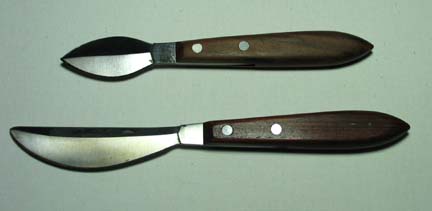
Many many of you commented on my technique of scraping back unsatisfactory passages in a painting in progress which was a common practice of painters such as John Singer Sargent and others. Pictured here are two scrapers from Dick Blick that I find irreplaceable tools in my studio, and I employ them often. The trick is to hold the blade at a right angle to the flat edge of the canvas. Even very dry hardened paint can be removed easily using this tool, and no need for turps or solvent of any kind.
Scrape carefully and firmly across the surface. Do not go too deep so as to raise or disturb the ground of the canvas. The blades are very sharp. Dried or wet paint will scrape off easily without any damage at all after you get the hang of it. I place a book or another hard object under the back surface of the canvas as a rigid support while scraping. Panels will work fine too. See a detailed description of the process in my September 3, 2008 blog entry on painting Penelope’s Web.
Always avoid using sandpaper for this purpose because the striations of the grit will embed into the surface of the paint leaving unsightly circular grooves.
After scraping the desired passage, I brush on a little oil or medium and repaint. I have saved many dogs using this magical tool!

Thank you for sharing this information. I had no idea that these scrapers would work on dried paint and I’ve been further ruining my paintings with sandpaper – which is what my art professors always told us to do! There’s so much more to learn – and I enjoy every moment of it. Your blog has been especially helpful.
Another new thing I didn’t know about…Thanks!